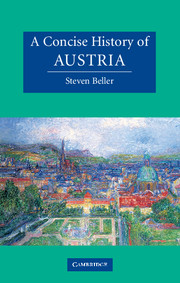Book contents
- Frontmatter
- Contents
- List of illustrations
- List of maps
- Acknowledgements
- Map 1 The Austrian Republic, 2006
- Introduction
- 1 The Eastern March, to 1439
- 2 AEIOU, 1439–1740
- 3 Countering reform, 1740–1866
- 4 Empire on notice, 1866–1918
- 5 The land without qualities, 1918–1945
- 6 Austria Inc., from 1945
- Conclusion
- Guide to further reading
- Index
- CAMBRIDGE CONCISE HISTORIES
- Frontmatter
- Contents
- List of illustrations
- List of maps
- Acknowledgements
- Map 1 The Austrian Republic, 2006
- Introduction
- 1 The Eastern March, to 1439
- 2 AEIOU, 1439–1740
- 3 Countering reform, 1740–1866
- 4 Empire on notice, 1866–1918
- 5 The land without qualities, 1918–1945
- 6 Austria Inc., from 1945
- Conclusion
- Guide to further reading
- Index
- CAMBRIDGE CONCISE HISTORIES
Summary
Austrians, it might be said, are a nation without a history, and Austrian history is a history without a nation. Only since 1945 have Austrians seriously tried to construct a national identity separate from that of Germans, and succeeded; yet Austria as an identifiable historical concept long antedates even the idea of the nation-state. For a small country such as modern-day Austria, with a population of only about 8 million, there is an awful lot of Austrian history.
Yet little of that history is straightforwardly ‘national’, and much of it refers to places and peoples far beyond Austria's current borders. Until 1918 ‘Austria’ was a multi-national, dynastic empire, otherwise known as the Habsburg Monarchy, in which the Germans of the Alpine hereditary lands (modern-day Austria, more or less) were only one ethnic ‘nationality’ among other ‘Austrians’ (such as Czechs, Ruthenians and so forth). While there was an ‘Austria’ in the form of the First Austrian Republic after 1918, few ‘Austrians’ regarded this as the best response to the Monarchy's collapse, most preferring Anschluss (union with Germany) instead. Between 1938 and 1945 this wish was fulfilled, but with horrific consequences, as National Socialist Germany incorporated Austrians in its war-and-murder machine and made them both complicit in the Holocaust and partners in total defeat.
- Type
- Chapter
- Information
- A Concise History of Austria , pp. 1 - 9Publisher: Cambridge University PressPrint publication year: 2007



